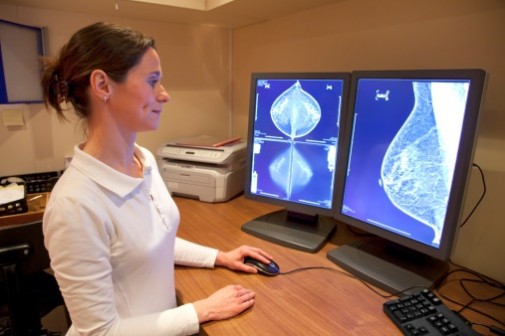5 benefits of 3D mammography
In the high-tech world, it’s the sexiest thing in breast screening technology, but 3D mammograms are more than just gadgetry. They are cutting down on the need for multiple tests and saving women a whole lot of angst about potentially positive diagnoses.
Using standard mammography, many women undergoing breast screening are asked to return for additional tests because of a suspicious density that appears in their scans. The request for more testing can prove a terrifying experience as the patient’s thoughts focus on the possibility that she has breast cancer.
Such anxious moments can now often be avoided, thanks to 3D mammography (breast tomosynthesis), an advanced tool that is FDA-approved. At the same time, 3D mammography aids in diagnosis if a tumor is present. The technology uses multiple angled images as the machine sweeps in an arc over a woman’s breast. The radiologist views these images sequentially. A mass will stand out in the scan—not be camouflaged by dense breast tissue as sometimes occurs with traditional 2D mammography.
“Breast tomosynthesis will benefit screening and diagnostic breast imaging patients and can be especially valuable for women receiving a baseline screening and for those who have dense breast tissue,” says Dr. Elizabeth Holland, radiologist at Advocate Christ Center for Breast Care.
The following are the top five benefits of 3D mammography according to Dr. Holland:
1) More accurate detection: By minimizing the impact of overlapping breast tissue, 3D mammography can make a tumor easier to see. Reviewing multiple images has helped doctors find more cancers than with 2D images alone.
2) Earlier diagnosis: Overlapping tissue can hide small cancers in a 2D scan. However, with 3D mammography, the image “slices” can be analyzed one by one. This means 3D mammography may help detect cancers earlier than conventional mammography.
3) Better detection in dense breast tissue: Dense breast tissue, often found in younger women, can cause shadows due to overlapping tissue, which hides tumors from traditional 2D mammography. 3D mammography takes images of the breast from multiple angles, thereby offering a cutting-edge look through and around breast tissue.
4) Less Anxiety: 3D mammography can help reduce false alarms. The improved accuracy in diagnosing abnormal structures offered by a 3D view of the breast decreases the number of unnecessary callbacks to women for additional scans and biopsies.
5) Safe and Effective: During a 3D mammogram, women will experience a minimal amount of additional radiation, compared with a standard mammogram. However, this dose is below the FDA-regulated limit for mammography, and no additional risk from an amount of radiation this small has been shown. The FDA studied the radiation issue before approving screening and diagnostic 3D mammography, concluding that the benefits outweigh any potential risk.
Breast cancer is the second leading cause of cancer deaths among women, exceeded only by lung cancer, according to the American Cancer Society. Detecting cancer at an earlier stage will influence a woman’s chance of survival.



















I guess Advocate Illinois Masonic doesn’t offer 3D – going back this week for more pictures :-(. Honestly I’m not worried but if this is state of the art why are old formats still around?
3D Mammography is still emerging. Facilities are lucky to just have one, they are very costly. In the future I bet most centers will all go 3D.
3 D mamography (tomosynthesis) is an emerging technique that has been shown to improve mammographic detection of breast cancer in some patients. However, it does almost double the radiation dose to women. Even if 3D mammography is performed, some women will still need to come back for additional imaging.
Other techniques, including whole breast screening ultrasound, something Advocate Illinois Masonic Medical Center (AIMMC) does offer, has been shown to detect more breast cancer in the screening population with dense breast than tomosynthesis.
Whole breast screening ultrasound is a supplemental screening tool. When used in conjunction with screening mammography, screening breast ultrasound can almost double the number of cancers detected in dense breast tissue.
So while AIMMC may not have one of the “hot” new techniques in breast imaging, we are happy to offer one we feel may be even better.
Had 2d & 3d mammo followed by diagnostic mammo followed by breast ultrasound – if all of these techniques are accurate, why did I undergo a vacuum assisted ultrasound guided mammo with a titanium (am allergic to sulfar) marker put in place followed by another mammo on breast.in the first place. Since technology doctor rated me BIRADs 4, I expected something would be found wrong. I was not aware that 80-85% of those biopsied get results of benign. That is a lot of women whose various tests should have been able to conclude no biopsy necessary. I can tell you that I will no longer be subject to this ever again. 80-85% is awfully high for all these biopsies to turn out as benign breast tissue. One week later and I have a rash where the needle/tube was inserted, pain, and what appears to be an incision that hasn’t closed. There is some definite overkill going on and I myself, will not subject myself to this again. P.S. I had no symptoms of BC.
I agree that sounds like overkill, but a word of csution: my Aunt had a similar experience. She decided to forgo amy mammograms for 6 years after that. She discovered a “strange strech mark” one day, and ignored it. She got a cyst near her armpit and treated it like a skin condition. When she finally saw a derm, he promptly referred her to a cancer doctor. She had stage 4 breast cancer, it spread throughout her body. She died 6 months later. She was 66.
I too, had a needle/tube biopsy that was benign. I had horrible pain for weeks afterwards. I was told immediately afterwards, the mass is much smaller now. My answer was ‘why didn’t you take all of the mass out’? No answer! A marker was inserted and later, they had me sign to insert the marker. Sounds like a law suit. Wasn’t that suppose to be BEFORE the marker was inserted? I would not have let them put it in, as the next time I tried to board a plane, I was pulled aside and searched, as the marker showed up. This was 2013 and now it’s 2017, and I haven’t had a problem since. Now, I’m debating about a 3 d mammogram, since my medicare pays 100%, but I am worried about 2-times the dose of radiation.